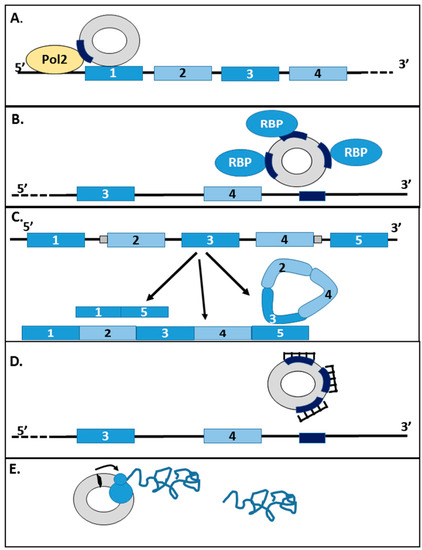Strategies for Circular RNA Synthesis
In recent decades, increasing evidence has disclosed that circular RNAs (circRNAs) are involved in many cellular processes and their dysfunction is strongly linked to the development of a variety of diseases. At present, they are being investigated as promising therapeutic targets. As a senior expert in the field of circRNA, Creative Biolabs is willing to share the techniques and strategies for circRNA synthesis as well as customized circRNAs synthesis services for customers all over the world.
Overview of CircRNAs
CircRNAs are defined as an extraordinary class of non-coding RNAs. Compared with common linear RNAs, they are covalently closed-loop structures, lacking free 3' and 5' ends. CircRNAs are widely distributed in many cells and play many vital functions in cells, such as serving as miRNA sponges, protein scaffolds and mRNA regulators. Additionally, they have been proven to be closely relevant to aging and cancer. It is worth noting that circRNAs also play a pivotal role in medical applications, such as gene therapy and circRNA vaccines.
 Fig.1 Proposed roles of circRNA in the regulation of transcription and translation.¹
Fig.1 Proposed roles of circRNA in the regulation of transcription and translation.¹
Roles of CircRNAs
- Regulating embryonic development;
- Controlling of cell cycle;
- Response to cellular stress;
- Involved in the regulation of cellular senescence.
Strategies for CircRNAs Synthesis
Relying on plasmids to enhance circRNA expression is an effective strategy to explore the function of circRNAs. In addition, overexpression of circRNAs via directly synthesized circRNAs is also an alternative. The in vitro generation of circRNAs involves two key steps, the synthesis and ligation of linear RNA. The process relies on a variety of chemical and enzymatic approaches, which can be mixed and matched. The resulting highly purified circRNA molecules can be delivered into target cells.
- Enzymatic ligation
A range of strategies are available for the enzymatic ligation of synthetic oligonucleotides. In general, enzymatic ligation is achieved by the reaction catalyzed by three different enzymes in bacteriophage T4 - T4 DNA ligase (T4 Dnl), T4 RNA ligase 1 (T4 Rnl 1) as well as T4 RNA ligase 2 (T4 Rnl 2). These enzymes catalyze the formation of a phosphodiester bond between a donor and an acceptor in DNA or RNA in an adenosine triphosphate (ATP)-dependent reaction.
- Ribozyme method
This system is the most prevalent ribozyme approach, also known as permuting introns and exons (PIE) approach. Currently, this method has gradually become a major choice for basic research and industrial production. Importantly, although this method is suitable for the production of most circRNAs, it is still affected by the structure of the second linear RNA precursors.
- Group II introns
This method is suitable for precise linear RNA precursor ligation. However, this method forms a phosphodiester bond at the site of attachment that differs from natural phosphodiester bonds. The mechanism of this method has not been fully studied at present.
- Hairpin ribozyme (HPR)
This method relies on the rolling circle reaction and self-splicing of circular single-stranded DNA templates to generate circRNAs. The HPR method plays a crucial role in the generation of small circRNAs, but this method is accompanied by the drawbacks of unstable products and exogenous HPR sequences.
With the deepening of research, circRNAs are playing an increasingly significant role in basic research and medical applications. As the leader in the field of gene therapy, our dedicated scientists are ready to start your circRNA project. For practical advice and professional assistance, please contact us.
Reference
- Haque, Shahnaz, and Lorna W. Harries. "Circular RNAs (circRNAs) in health and disease." Genes 8.12 (2017): 353.
